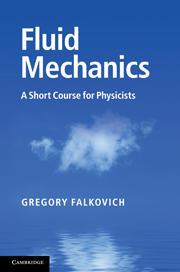2 - Unsteady flows
Published online by Cambridge University Press: 05 June 2012
Summary
Fluid flows can be kept steady only for very low Reynolds numbers and for velocities much less than the velocity of sound. Otherwise, either flow experiences instability and becomes turbulent or sound and shock waves are excited. Both sets of phenomena are described in this chapter.
A formal reason for instability is non-linearity of the equations of fluid mechanics. For incompressible flows, the only non-linearity is due to fluid inertia. We shall see how a perturbation of a steady flow can grow due to inertia, thus causing an instability. For large Reynolds numbers, the development of instabilities leads to a strongly fluctuating state of turbulence.
An account of compressibility, on the other hand, leads to another type of unsteady phenomena: sound waves. When density perturbation is small, velocity perturbation is much less than the speed of sound and the waves can be treated within the framework of linear acoustics. We first consider linear acoustics and discover what phenomena appear as long as one accounts for a finiteness of the speed of sound. We then consider non-linear acoustic phenomena, the creation of shocks and acoustic turbulence.
Instabilities
At large Re most of the steady solutions of the Navier–Stokes equation are unstable and generate an unsteady flow called turbulence.
Kelvin–Helmholtz instability
Apart from a uniform flow in the whole space, the simplest steady flow of an ideal fluid is a uniform flow in a semi-infinite domain with the velocity parallel to the boundary.
- Type
- Chapter
- Information
- Fluid MechanicsA Short Course for Physicists, pp. 54 - 85Publisher: Cambridge University PressPrint publication year: 2011



